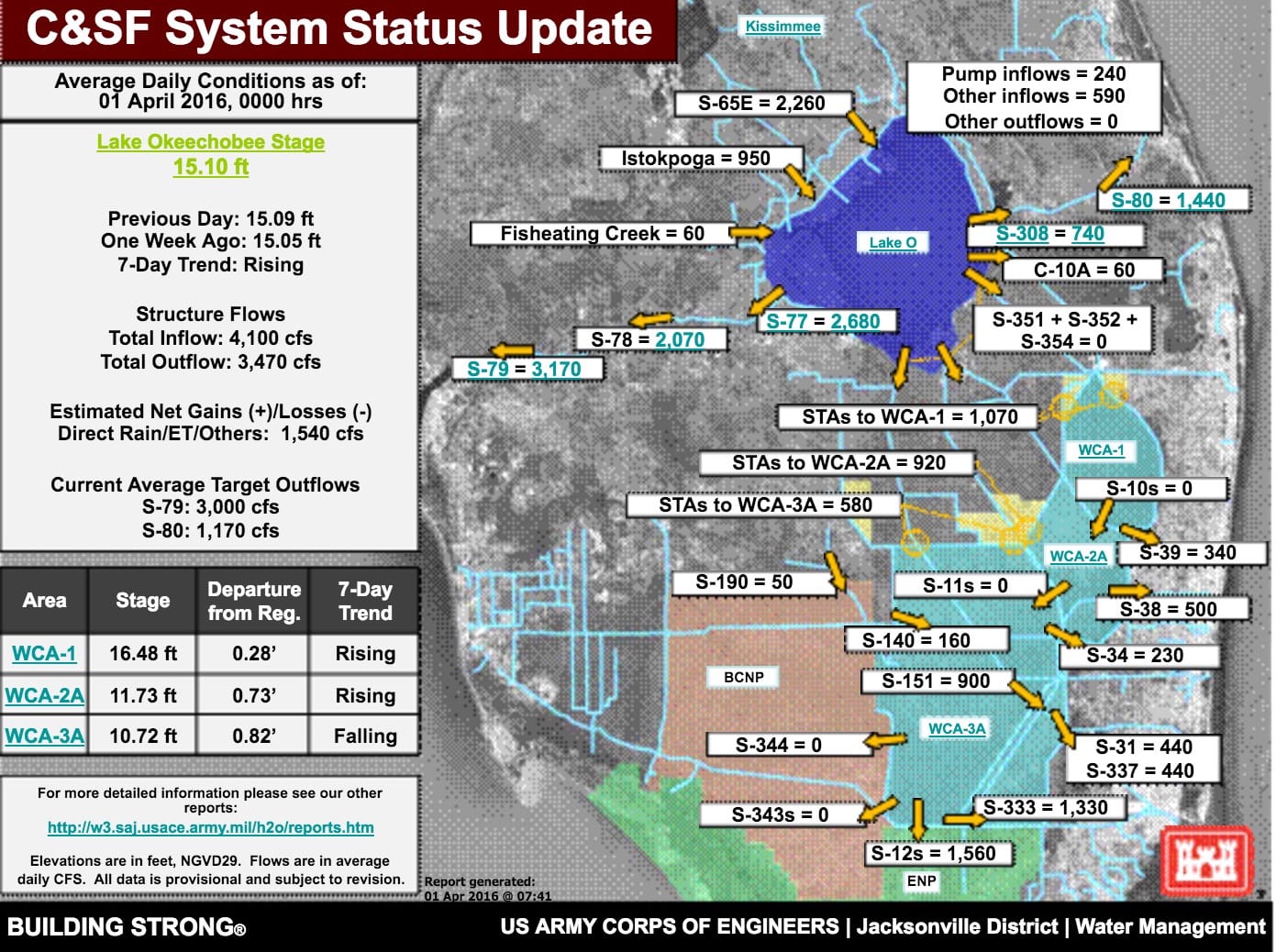
DEP’S Daily Lake Okeechobee Water Release Update, 4-1-16
Caloosahatchee Low Salinity Levels Threaten Fish Spawns. Lake Inflows & Level Increased Over The Last Week.
Scientists raised concern about record low salinity levels in the Caloosahatchee estuary in a report issued this week.
“Findings found that the salinity was too low in many parts of the Caloosahatchee River. Near McIntyre Creek and Tarpon Bay, scientist found that salinity was at a record low that will impact the survival of sea grass. No samples of red tide were reported.
Their recommendation for immediate implementation is to reduce the water releases to 2,800 cubic feet per second, which they say is critical to save eggs and larvae in the estuary.” WINK NEWS
Separately DEP issued Friday’s daily update on Lake Okeechobee Water Releases and lake inflows and the level of the lake both increased over the last week.
DEP’S Daily Lake Okeechobee Water Release Update, Friday, April 1.
Rainfall for the current week is forecast to be above average. Daytime heating is expected to generate mainly afternoon showers and thunderstorms in the north today before the next frontal boundary moves into the area on Saturday.
The Department of Environmental Protection issued the Daily Lake Okeechobee Water Release update.
For Immediate Release: April 1, 2016, 4:44 PM/E
Caloosahatchee Salinity Conditions: Salinity (based on optimal conditions for adult oysters) is in the good range at Shell Point and Sanibel, and in the poor range at Cape Coral.
St. Lucie Salinity Conditions: Salinity at the U.S. 1 bridge is within the fair range. The salinity at A1A is in good condition. Localized heavy rainfall has resulted in salinity levels lowering slightly.
Rainfall Forecast: “Rainfall for the current week is forecast to be above average. Daytime heating is expected to generate mainly afternoon showers and thunderstorms in the north today before the next frontal boundary moves into the area on Saturday. Daytime heating will then generate mainly afternoon showers and thunderstorms focused north and east of the lake on Saturday, and south and east of the lake on Sunday.”
As of March 31, 2016, water levels within the three WMAs previously listed are approaching criteria for rescinding the special regulations that limit public access. Criteria for rescinding the special regulations is a combination of water level and wildlife observed on surrounding levees. Water levels in all three WMAs listed above experienced a slight increase in water levels or remained unchanged due to precipitation received during the past 48 hours.
- Everglades WMA:
- Water level (average of 62/63 gauges) as of March 31 = 11.33 feet
- High water closure criteria = 11.60 feet
- Regulation schedule = 9.90 feet
- Average for this time of year = 9.96 feet
- Ascension rate for the last week = 0.03 feet
- Water level trend over the past 3 weeks = dropping
Rotenberger WMA:
- Water level as of March 31 = 12.95 feet
- High water closure criteria = 13.50 feet
- Regulation schedule = 12.56 feet
- Average for this time of year = 12.25 feet
- Ascension rate for the last week = 0.01 feet
- Water level trend over the past 3 weeks = dropping
Holey Land WMA:
- Water level as of March 31 = 12.05 feet
- High water closure criteria = 12.50 feet
- Regulation schedule = 11.26 feet
- Average for this time of year = 10.76 feet
- Ascension rate for the last week = 0.05 feet
- Water level trend over the past 3 weeks = dropping
For more information and the complete data, please see DEP.